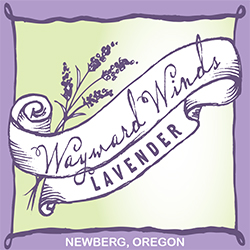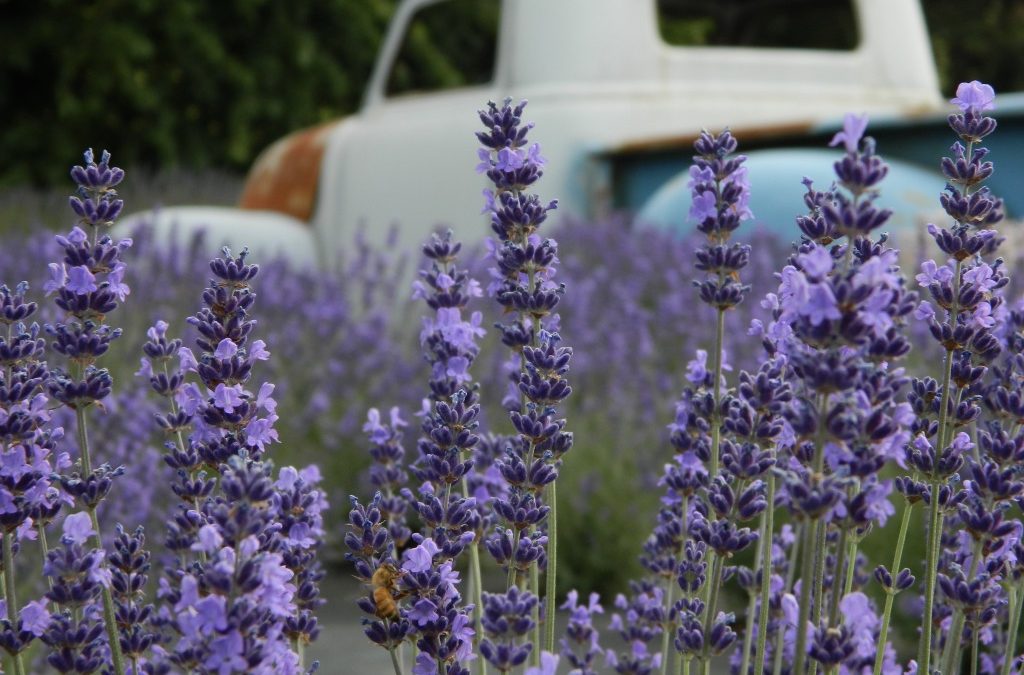Do I need to do anything special to my soil before planting lavender?
- Lavender likes to be in soil that hovers right around 7 on the pH scale (no less than 6.5 and no more than 7.5).
- Dig up a shovel full and get your hands in it. What does it feel like? What do you see?
- Is it light and fluffy? Does it crumble and fall apart easily as you squeeze it in your hand? Is there a mix of different-sized particles in it? If so it likely has a balanced ph and would be considered loam-type soil.
- Is it thick and sticky? Does it squish between your fingers when you squeeze it and stay together like clay for a potter’s wheel? Does it all look like the same smooth texture with maybe a few larger rocks in it? Then you likely have an acidic clay soil.
- Is it more like sand than dirt? Does it have granules you can see, but it’s pretty uniform? Does it fall apart with barely a touch and sift through your fingers? Then you likely have alkaline sandy soil.
- We typically plant our lavender directly in the soil with very few amendments.
- However, if you have clay soil and you’d like to amend your soil Sarah Berringer Bader in her book The Lavender Lover’s Handbook says, “The best option for clay soil is a lot of organic matter, a shovel, or tiller, and a strong back”.
- Amend soil with organic matter to add air pockets and better drainage. You are aiming for fluffy soil.
- Some people have found luck by aiming for ⅓ inorganic filler in their lavender beds. Beware of adding sand as this can make our Oregon clay soil turn to near concrete. Test for yourself and see how your soil does before prepping too much area for lavender.
How much water should I give my lavender? Should I irrigate it?
- Waterlogged soil is the most common reason lavender plants die.
- All lavenders like their feet dry and need water to drain quickly from the soil around their roots.
- Root rot, most often Phytophthora, thrives in poorly drained, dense soil. It will kill your lavender. Once root rot gets started it is impossible to stop. The best approach to combating root rot is to not let it happen in the first place.
- Root rot will make your plant look like it is dried out and dying from under watering. This is because it affects the roots and kills them, therefore not allowing the plant to take up nutrients and water it needs and causing the plant to dry out and die.
- We usually plant our lavender in early Spring or Fall so that we do not have to water it. We do not water during the summer and we have never had a problem with it here in Oregon. If you water your lavender try not to overhead water.
Do you recommend mounding lavender if I have ground that doesn’t drain very well?
- Some people like to mound their lavender if their soil doesn’t drain well.
- This is not always the answer as a lavender plant’s roots can extend past the depth and width of the mound and then find waterlogged soil after it is well established. In cases like this the plant will do well until its roots reach beyond the mound. It will then struggle and perhaps die years after it has been established.
- Mounding can help with air circulation in branches of the plant, though, which is also important for healthy lavender.
- If you want to mound your beds to improve drainage, make the mound large enough to expand past the roots of the mature plant (each variety will differ. Dour research before planting).
What is the best way to plant lavender?
- Plant in fall or spring.
- Your lavender needs at least 6 hours of full sunlight a day, year around.
- Plants should be spaced so that when they reach maturity their foliage will still have plenty of air circulation. For an average-sized lavender plant that will be about 3 feet apart. Do your research on your varieties’ average size before planting.
- Wayward Winds’ tried and true way to plant lavender: 1) dig a hole about 18 inches wider and deeper than the roots 2) fill the hole with water and let it drain naturally 3) after it drains fully plant the lavender and gently tamp sail around the plant 4) thoroughly water soil around the lavender.
What about fertilizer?
- Nitrogen (N) encourages foliage growth, often at the expense of the blooms and roots. Don’t add fertilizers high in this number. Use only low nitrogen fertilizers.
- Phosphorous (P) encourages root development. Add a fertilizer high in P when you first plant your lavender to help establish the roots or right before the lavender blooms.
- Potassium (K), also called potash, boosts plant tolerance to stress such as drought or varying temps. Apply in the fall after harvest to strengthen the plant through the winter.
- NOTE: Fertilize only according to what your plant needs or what you want from your plant. Some experts feel that lavender does better under stress, and certainly produces a better quality oil. This makes sense as in the wild it tolerates heat and dryness very well. If your plants seem to be doing fine and you are getting lovely blooms, leave it alone, don’t fertilize it. We rarely fertilize our plants once we put them in the ground here at the farm.
How do you prune lavender?
(For a more extensive post on pruning read this blog post.)
In the 1st year:
- Pinch off any odd length branches and blossoms, right after you plant them in the ground.
- DO NOT be tempted to leave the blooms on the bush, as this detracts from establishing its roots.
- A couple of weeks later, go back and prune again. Using pruners, leave some leafy softwood intact, but cut a couple of inches above the leafless wood.
- If you go back and do this a couple of times during the first growing season your lavender plant will grow in fuller and more robust.
In the 2nd year
- Prune in spring or after harvest.
- With pruners, cut through stems a couple of inches above the bare wood, leaving a few nodes on each branch.
- Trim around base to shape the plant into a nice round mound, like a muffin top.
In the 3rd year and beyond
- Prune in spring or after harvest in Fall.
- You know technically have a mature plant, although it will keep growing, especially if it is not pruned properly.
- Using a serrated sickle, grab handfuls of green tender branches and cut them back to an inch or two above the bare-wood branches, leaving 3-4 nodes per branch.
- This will feel severe, but it will keep your lavender plant from going woody for many more years to come 6-10 years.
- NOTE: This is from the USLavender Growers Association “There are many ways to prune lavender. ‘If you like roses you’ll love Lavender’ Lila Avery-Fuson says. ‘Lavender, like the rose, does not like wet feet and loves to be cut hard, just remember the harder you cut it the more it shows!’ Her advice is to not be afraid to take it down each year within 2/3 of the root ball just after the last frost in spring. This will encourage new growth and a strong stem length along with a judicious application of fish emulsion. Sarah Richards says “Give lavender a 1 ½ inch green crew cut.” She says you measure the green from where the woody stems start sprouting out new, green growth.”
How do you harvest Lavender?
- If you want to pick lavender for drying or for culinary use, do so after the first couple of buds burst, this helps the buds stay on the stem. Wrap bunches with twine or rubber bands and hand to dry.
- If you want a beautiful bouquet, pick when blooms are not quite halfway bloomed.
- If you want to just leave the blooms on the plant in your garden be sure to cut them back after the bloom cycle is finished, lest you stress the plant too much.
- Remove the bud from the stem by rolling it between your palms. Then place in a colander and sift to remove debris.
- Your bud is ready to be used.
We hope this basic information helps your lavender thrive for years to come!
Kristen & The Wayward Winds Team



